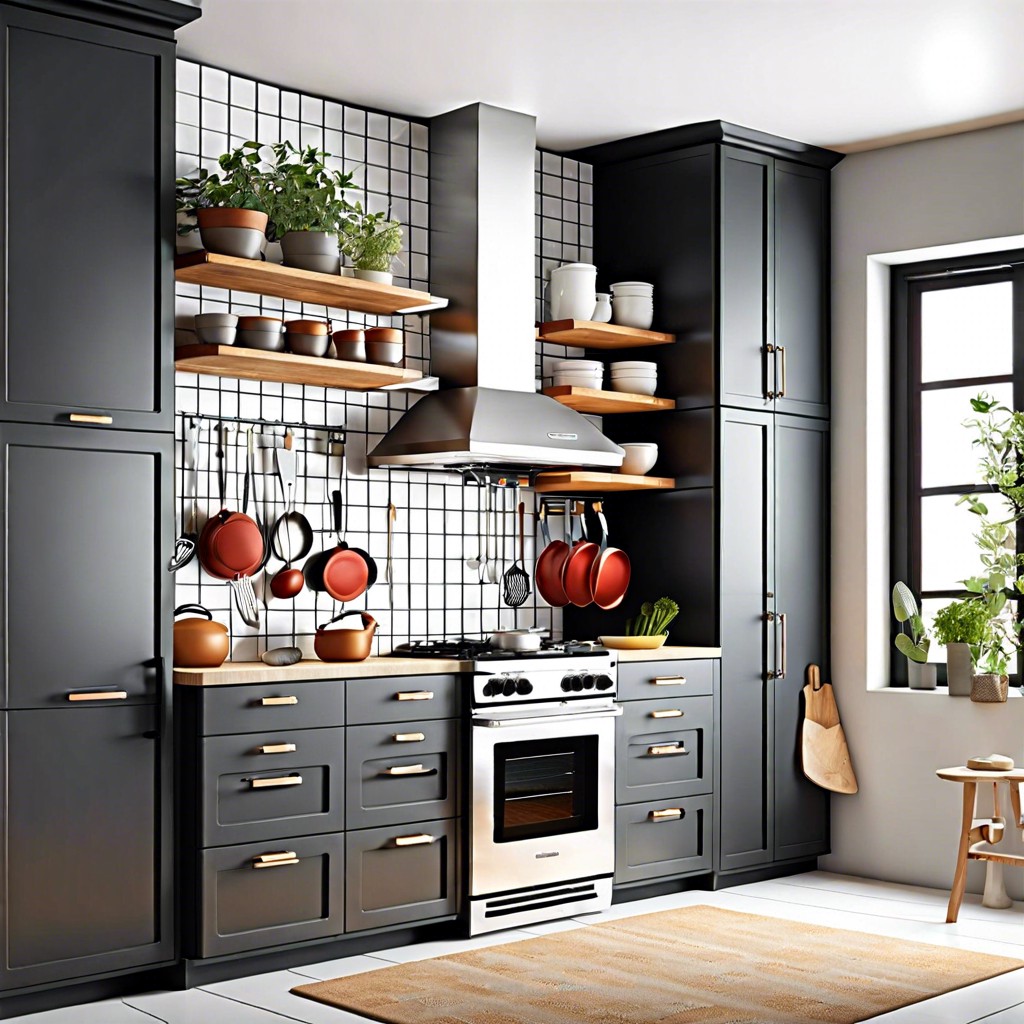Last updated on
Maximize your small kitchen space with practical organization tips and smart storage solutions to create a functional and clutter-free cooking area.
Key takeaways:
- Use vertical space efficiently: Install shelves, hanging pot racks, and magnetic strips to maximize storage.
- Maximize cabinet storage: Utilize stacking shelves, drawer organizers, and pull-out organizers.
- Opt for wall-mounted storage: Install shelving units, ceiling-mounted racks, pegboards, and magnetic knife strips to make the walls work for you.
- Utilize door racks and hooks: Attach racks and hooks to the back of cabinet doors for extra storage.
- Focus on counter space utilization: Prioritize essential items, invest in cutting boards that fit over the sink, and use stackable storage containers.
What's Inside
Use Vertical Space Efficiently

Leveraging the height of your kitchen aids in keeping counters clear and ensuring every item has a place. Start by installing shelves above the sink or counter; this area often goes unused but is ideal for storing items you use regularly, such as dishes and glasses. If there’s space between the ceiling and your cabinets, consider adding storage baskets for infrequently used gadgets or seasonal items. Furthermore, hanging pot racks can be a stylish and functional way to store pots and pans while freeing up cabinet space. Lastly, magnetic strips can hold knives and utensils, keeping them handy and off the counter. With these tweaks, you can turn every inch of your kitchen into a functional storage area.
Maximize Cabinet Storage
Stacking shelves and drawer organizers are your allies in the quest to conquer cabinet chaos. They double your storage space by enabling you to use the full height of your cabinets, eliminating the need to stack dishes precariously.
For pots and pans, consider pull-out organizers. They slide out, allowing for easy access without the hassle of digging through a cluttered cabinet. For lids, use a tension rod as a makeshift divider, keeping them upright and in order.
When it comes to food storage containers, nest them by size with their lids stored nearby, possibly on a separate rack for simplicity. Avoid container anarchy by only keeping lids that have corresponding partners.
Don’t forget the inside of the cabinet doors. Attach shallow caddies or spice racks here to store small items that get lost in larger cabinets. This could be the perfect spot for measuring spoons, tea infusers, or small jars.
Lastly, reassess your kitchenware regularly. Keep what you use frequently within easy reach and consider donating lesser-used items. A decluttered cabinet not only looks better, but it also functions more efficiently, saving you time and stress.
Opt for Wall-Mounted Storage
Harnessing wall space can transform a cramped kitchen into a functional haven. Shelving units above the sink or countertops provide homes for dishes, glasses, or spices. For those often-used pots and pans, a ceiling-mounted rack becomes both a decorative feature and a practical storage solution. Pegboards offer a customizable space where you can hang utensils, small pots, and even planters, keeping them accessible yet out of the way. Magnetic knife strips are also a sleek way to store knives, freeing up valuable drawer space. Remember, making the walls work for you goes beyond shelves and hooks; consider adding a fold-down table or additional work surface that can be stowed away when not in use. When considering wall storage, ensure it’s within easy reach and securely mounted to handle the load.
Utilize Door Racks and Hooks
Transforming the back of a cabinet door into a smart storage solution is like finding hidden treasure in your own kitchen. By installing racks and hooks on these often-overlooked spaces, you amplify your kitchen’s organizational capacity without encroaching on valuable working areas.
Imagine the convenience of having all your measuring cups neatly hung inside a cabinet door, each one visible and accessible. Attach a skinny rack to stash pot lids, chopping boards, or baking trays, instantly eliminating clutter from shelves and countertops.
Don’t overlook your pantry or closet doors either. Here’s a perfect spot for spice racks, offering you a clear view of your seasonings at a glance, saving you from the frustrating search through a crowded cabinet during cooking.
When selecting door racks or hooks, pay attention to the door’s weight capacity and the depth of your shelving—you don’t want to impede the door’s closure or damage your storage. Measure carefully before purchasing, and choose wire racks or clear organizers that allow you to see contents easily. Hooks for utensils or small hanging baskets can turn any kitchen door into a multifunctional space, boosting your kitchen’s efficiency.
Focus On Counter Space Utilization
A clear counter is key to a functional small kitchen. To achieve this, prioritize appliances and items that are essential for daily use. Consider a designated area for small appliances that are used frequently; a coffee maker or toaster can have their own spots, while less-used items should be stored away to avoid clutter.
Investing in cutting boards that fit over the sink can extend prep space conveniently. This acts as an additional surface for chopping vegetables or preparing ingredients and can be easily cleaned and stored away.
Magnetic knife strips save drawer space and keep knives within reach. Similarly, collapsible items like silicone colanders or foldable dish racks can be expanded for use and tucked away when not needed.
To limit countertop usage, use stackable storage containers for dry goods. These can often be more space-efficient than leaving original packaging out. When every inch counts, even choosing a soap dispenser with a smaller footprint can make a difference.
Keep the counter free by hanging items like paper towels, utensil holders, or spice racks. Maintaining a minimalist approach to what stays on the counter not only saves space but also creates a visually more expansive and organized kitchen.




